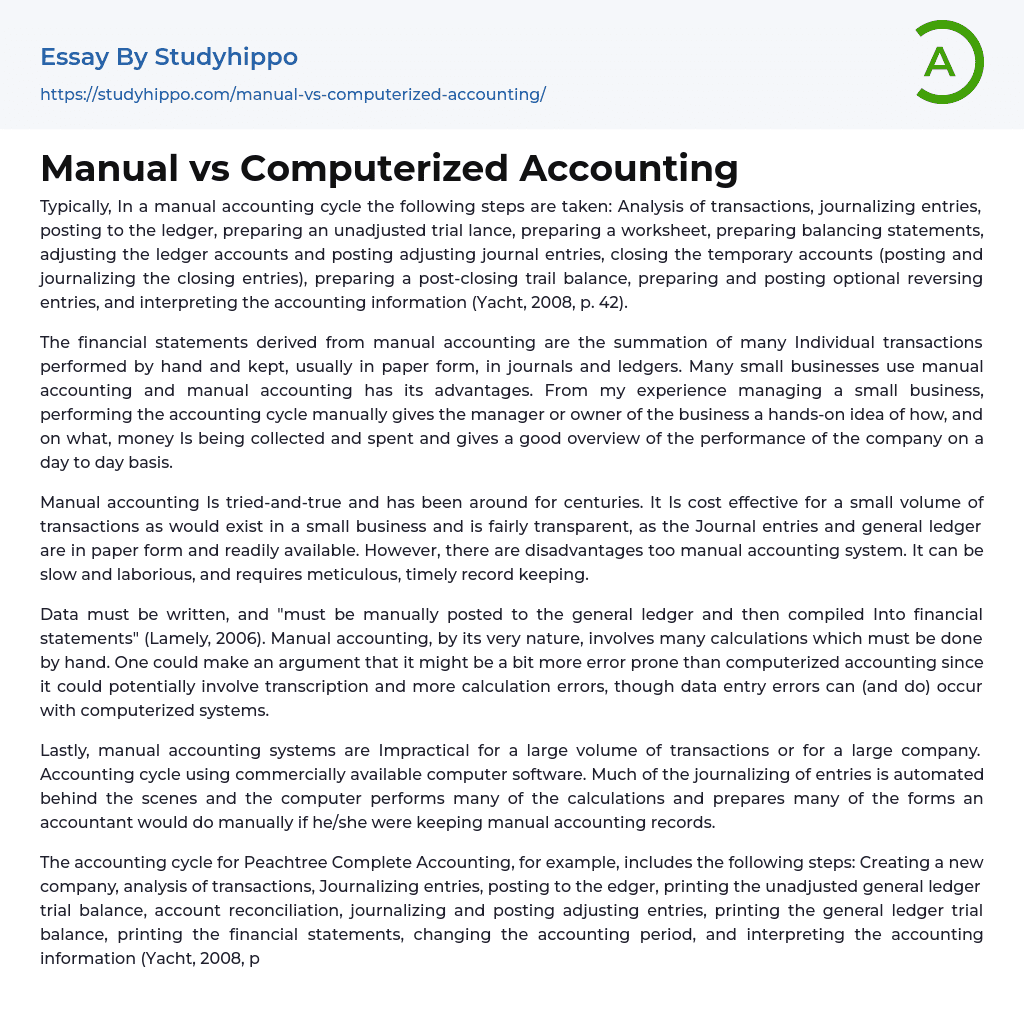Typically, the manual accounting cycle involves several steps. These steps include analyzing transactions, journalizing entries, posting to the ledger, preparing an unadjusted trial balance, creating a worksheet, preparing balancing statements, adjusting the ledger accounts and posting adjusting journal entries, closing temporary accounts (posting and journalizing closing entries), preparing a post-closing trial balance, preparing and posting optional reversing entries, and interpreting the accounting information (Yacht, 2008, p. 42).
The financial statements produced through manual accounting involve consolidating many individual transactions that are executed and recorded manually, usually on paper in journals and ledgers. Small businesses often use manual accounting for its various advantages. Drawing from my own experience managing a small business, carrying out the accounting process manually gives the manager or owner a direct understanding of how funds are acquired and utilized, alo
...ng with a complete overview of the company's daily performance.
Manual accounting is a cost-effective and transparent option for small businesses with a low volume of transactions. It has been used for centuries, and the journal entries and general ledger are in paper form, making them easily accessible. However, manual accounting can be time-consuming and requires meticulous and timely record keeping.
According to Lamely (2006), data must be manually posted to the general ledger and compiled into financial statements. Manual accounting involves calculations done by hand, making it potentially more error prone than computerized accounting. This is because manual accounting may involve transcription and calculation errors, although data entry errors can occur with computerized systems as well.
In conclusion, manual accounting systems prove to be impractical for extensive transactions or large corporations. However, with the use of commercially available computer
software, the accounting cycle becomes more efficient. The computer automates entry journalizing, calculations, and form preparation, tasks that an accountant would typically perform manually when maintaining manual accounting records.
The accounting cycle for Peachtree Complete Accounting, for instance, involves the following steps: Creating a new company, analyzing transactions, Journalizing entries, posting to the edger, printing the unadjusted general ledger trial balance, reconciling accounts, journalizing and posting adjusting entries, printing the general ledger trial balance, printing the financial statements, changing the accounting period, and interpreting the accounting information (Yacht, 2008, p. 45). In a computerized accounting system, data is manually entered into the computer, while most calculations are automated for the user.
Computerized accounting systems offer several advantages. They enhance the speed and efficiency of the accounting process by automating tasks such as journalizing and calculation. This automation reduces the need for manual labor. Additionally, computerized systems automate the summation of transactions and enable quick and easy printing of financial statements. While data entry errors may still occur, they are easier to identify in a computerized system, and there is no risk of transcription errors since the computer handles the transcription process.
Computerized accounting systems are beneficial for large companies with a high transaction volume as they efficiently manage numerous transactions. Additionally, these systems save time by generating financial statements at any stage of the accounting cycle, unlike manual accounting which is more time-consuming. Nevertheless, it should be recognized that computerized accounting systems also have their disadvantages.
Computerized accounting systems may be too costly for small businesses and not within their budget due to limited start-up funds. Moreover, depending on computers for accounting poses challenges such
as power outages, virus risks, data security concerns, and the possibility of computer fraud. Additionally, I hold the opinion that computerized accounting systems lack transparency in comparison to manual accounting. While it is possible to access journal entries and the general ledger by drilling down, they often prove perplexing to individuals who are not well-versed or acquainted with accounting principles.
Computerized accounting, which requires specialized computer knowledge, is more costly in terms of employee expenses compared to manual accounting. This becomes especially important as many companies currently delegate their accounting tasks to countries like India with lower labor costs. In the article "Cost Savings from Computerized Accounting are Not What They Should Be" (Lamely, 2006), the author emphasizes the significant learning curve associated with effectively using the software and suggests that unauthorized accounting may not necessarily be cheaper or less error-prone than manual accounting. Despite these differences, both manual and computerized accounting systems have a common starting and ending point: business transactions and financial statements and reports that adhere to accounting principles and double entry accounting. Each system has its own advantages and disadvantages, but neither is inherently superior or inferior to the other. Ultimately, businesses must decide whether to implement a manual or computerized accounting system.
- Accounts Receivable essays
- Auditor's Report essays
- Balance Sheet essays
- Costs essays
- Financial Audit essays
- International Financial Reporting Standards essays
- Tax essays
- Accountability essays
- Cash essays
- Principal essays
- Management Accounting essays
- Internal Control essays
- Accounting Software essays
- Cash Flow essays
- Computer File essays
- Desktop Computer essays
- Servers essays
- Accounting essays
- Andrew Carnegie essays
- Automation essays
- Business Cycle essays
- Business Intelligence essays
- Business Model essays
- Business Operations essays
- Business Software essays
- Cooperation essays
- Cooperative essays
- Corporate Social Responsibility essays
- Corporation essays
- Customer Relationship Management essays
- Family Business essays
- Franchising essays
- Harvard Business School essays
- Harvard university essays
- Human Resource Management essays
- Infrastructure essays
- Inventory essays
- Logistics essays
- Management essays
- Manufacturing essays
- Market essays
- Marketing essays
- Multinational Corporation essays
- News Media essays
- Online Shopping essays
- Quality Assurance essays
- Richard Branson essays
- Sales essays
- Selling essays
- Shopping Mall essays




